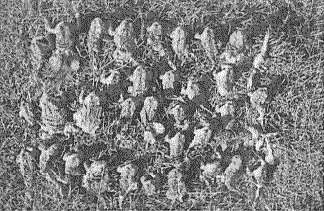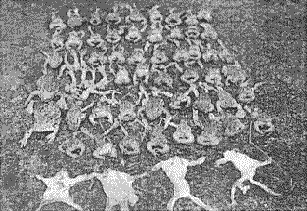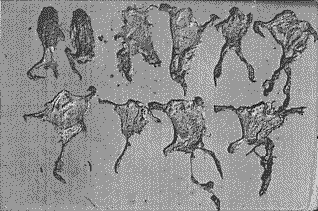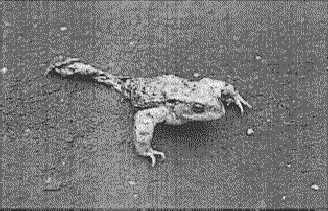 |
Last Update:
Thursday November 22, 2018
|
| [Home] |
|
Volume 19 Issue 1 Pages 1 - 61 (April 2002) Citation: Slater, F. (2002) Progressive Skinning of Toads (Bufo bufo) by the Eurasian Otter (Lutra lutra). IUCN Otter Spec. Group Bull. 19(1): 25- 29 Progressive Skinning of Toads (Bufo bufo) by the Eurasian Otter (Lutra lutra) Fred Slater Cardiff University Field Centre, Newbridge-on-Wye, Powys, LD1 6NB, UK. (received 3 May 2002, accepted 5 June 2002)
INTRODUCTION The fact that Lutra lutra will predate frogs and toads is a widely reported phenomenon (ERLINGE, 1967; FAIRLEY, 1984; FAIRLEY and McCARTHY, 1985; JENKINS and HARPER, 1980; LOPEZ-NIEVES et al., 1984; WEBER, 1990). In Britain, such behaviour has been reported from England, Scotland, Ireland, and Wales, including the River Esk in Scotland, where it was first attributed to Chinese Restaurants mutilating toads for their legs, although later recognised as the work of otters. Hind leg predation has been reported over a wide area of central Wales and involved both anuran species present in the study area: common frog (Rana temporaria) as well as the common toad (Bufo bufo). My records date back to the mid-1990's and record predation on a population of B. bufo inhabiting river flushed pools in an area of braided channels along the upper River Wye in mid-Wales. When the toads come to these pools to breed in April, they are taken by otters and their hind legs skinned and eaten and the front half of the toad discarded, presumably because of the presence of large paratoid glands just behind the eyes, which exude powerful toxins. Frogs eaten in a similar way have been reported from a large reservoir some 20 km to the west, in a completely different catchment, and at man-made pools some 15 km northeast of the original river toad site. The fact that the frogs have non-toxic skin but still only lose their hind legs suggests the otters in all cases regard all anurans as toads and treat them accordingly. OBSERVATIONS All the toads found predated at the River Wye site, were collected and photographed in 1997, 1999 and 2002 (in 2001 there was no access due to Foot and Mouth disease restrictions). Although the numbers found varied from year to year, it has become obvious that the percentage completely skinned and the whole body consumed has increased over the six-year period (Table 1).
Otters are widespread in mid-Wales but there are only sporadic reports of this type of behaviour. To determine how widespread this behaviour might be we examined amphibian bones within otter spraints from a number of sites within the Wye catchment, sufficiently separated to make it likely that samples from different sites came from different otters (Poore, unpublished data). The anuran bones were separated from the spraints and examined to see if there were proportionately more hind limb bones than forelimbs. The result, significant at the 5% probability level, showed a greater number of animals if counted by paired hind limb bones that if front limb and non-paired amphibian bones were assessed. DISCUSSION Although based on a limited sample size, it would appear that otters have found that eating only the hind legs of anurans avoids toxins in the glandular front end of toads. At at least one study site, otters appear to have found that the whole of the amphibian body is edible if the skin is fully removed. This is almost always achieved via a vertical incision and the skin then removed in one piece. The progressive increase in the percentage of fully skinned animals over time at one location suggests a learning process. Data on skinning are not available from others sites as reports of otter-eaten frogs or toads are sporadic and the remaining corpses quickly removed by scavengers. One hundred predated frogs were all removed by Carrion Crows (Corvus corone) over a two hour period, making the window of opportunity for recording particularly narrow. At the river site, discarded bodies are generally left in the water away from most scavengers so are available for collection for several days. Eventually, these bodies are either eaten by caddis larvae (Trichoptera) or washed away by rising river levels.
When only the hind limbs are taken, they are always skinned and the skin left attached to the remaining part of the animal (also noted by WEBER, 1990), which may still be alive and even able to walk (Figure 4). That hind limb removal is a fairly general phenomenon in mid-Wales is suggested by spraint analysis, showing that hind limb to fore limb anuran bone ratio shows an excess of hind limbs. In a river system where traditional food resources are in decline - salmon, eels freshwater crayfish - better utilisation of the residual food resource is clearly a useful survival strategy and total skinning of the carcase is a means to that end. ACKNOWLEDGEMENTS - I acknowledge the facilities provided by the Llysdinam Charitable Trust and the assistance of Emma Poore in analysing spraint samples. REFERENCES Erlinge, S. 1967. Food habits of the
fish-otter, Lutra lutra L. in south Swedish habitats. Vilrevy
4, 371-431. Résumé : Ecorchage Progressif de Crapauds (Bufo
bufo) par la Loutre Eurasienne (Lutra lutra) Resumen: Desollado Progresivo de
Sapos (Bufo bufo) por la Nutria Europea (Lutra lutra) |
||||||||||||||||||||||||||||||||
| [Copyright © 2006 - 2050 IUCN/SSC OSG] | [Home] | [Contact Us] |



